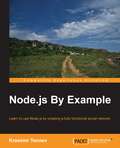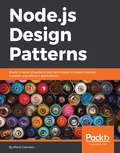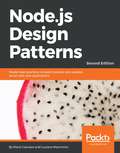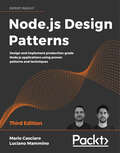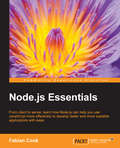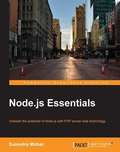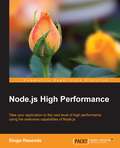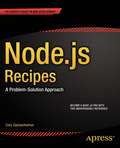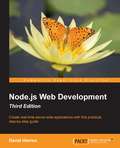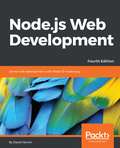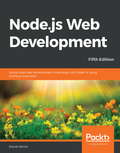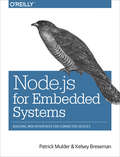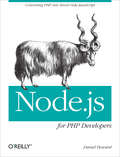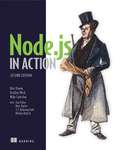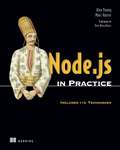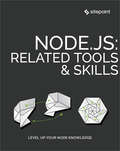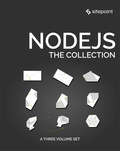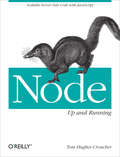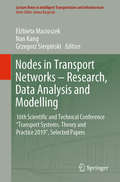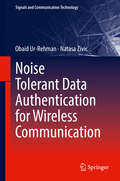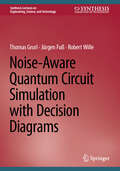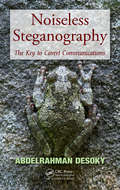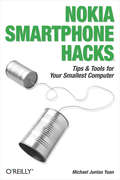- Table View
- List View
Node.js By Example
by Krasimir TsonevIf you are a JavaScript developer with no experience with Node.js or server-side web development, this book is for you. It will lead you through creating a fairly complex social network. You will learn how to work with a database and create real-time communication channels.
Node.js Design Patterns
by Mario CasciaroIf you're a JavaScript developer interested in a deeper understanding of how to create and design Node.js applications, this is the book for you.
Node.js Design Patterns - Second Edition
by Mario Casciaro Luciano MamminoGet the best out of Node.js by mastering its most powerful components and patterns to create modular and scalable applications with ease About This Book * Create reusable patterns and modules by leveraging the new features of Node.js . * Understand the asynchronous single thread design of node and grasp all its features and patterns to take advantage of various functions. * This unique guide will help you get the most out of Node.js and its ecosystem. Who This Book Is For The book is meant for developers and software architects with a basic working knowledge of JavaScript who are interested in acquiring a deeper understanding of how to design and develop enterprise-level Node.js applications. Basic knowledge of Node.js is also helpful to get the most out of this book. What You Will Learn * Design and implement a series of server-side JavaScript patterns so you understand why and when to apply them in different use case scenarios * Become comfortable with writing asynchronous code by leveraging constructs such as callbacks, promises, generators and the async-await syntax * Identify the most important concerns and apply unique tricks to achieve higher scalability and modularity in your Node.js application * Untangle your modules by organizing and connecting them coherently * Reuse well-known techniques to solve common design and coding issues * Explore the latest trends in Universal JavaScript, learn how to write code that runs on both Node.js and the browser and leverage React and its ecosystem to implement universal applications In Detail Node.js is a massively popular software platform that lets you use JavaScript to easily create scalable server-side applications. It allows you to create efficient code, enabling a more sustainable way of writing software made of only one language across the full stack, along with extreme levels of reusability, pragmatism, simplicity, and collaboration. Node.js is revolutionizing the web and the way people and companies create their software. In this book, we will take you on a journey across various ideas and components, and the challenges you would commonly encounter while designing and developing software using the Node.js platform. You will also discover the "Node.js way" of dealing with design and coding decisions. The book kicks off by exploring the basics of Node.js describing it's asynchronous single-threaded architecture and the main design patterns. It then shows you how to master the asynchronous control flow patterns,and the stream component and it culminates into a detailed list of Node.js implementations of the most common design patterns as well as some specific design patterns that are exclusive to the Node.js world.Lastly, it dives into more advanced concepts such as Universal Javascript, and scalability' and it's meant to conclude the journey by giving the reader all the necessary concepts to be able to build an enterprise grade application using Node.js. Style and approach This book takes its intended readers through a comprehensive explanation to create a scalable and efficient real-time server-side apps.
Node.js Design Patterns: Design and implement production-grade Node.js applications using proven patterns and techniques, 3rd Edition
by Mario Casciaro Luciano MamminoLearn proven patterns, techniques, and tricks to take full advantage of the Node.js platform. Master well-known design principles to create applications that are readable, extensible, and that can grow big. Key Features Learn how to create solid server-side applications by leveraging the full power of Node.js 14 Understand how Node.js works and learn how to take full advantage of its core components as well as the solutions offered by its ecosystem Avoid common mistakes and use proven patterns to create production grade Node.js applications Book Description In this book, we will show you how to implement a series of best practices and design patterns to help you create efficient and robust Node.js applications with ease. We kick off by exploring the basics of Node.js, analyzing its asynchronous event driven architecture and its fundamental design patterns. We then show you how to build asynchronous control flow patterns with callbacks, promises and async/await. Next, we dive into Node.js streams, unveiling their power and showing you how to use them at their full capacity. Following streams is an analysis of different creational, structural, and behavioral design patterns that take full advantage of JavaScript and Node.js. Lastly, the book dives into more advanced concepts such as Universal JavaScript, scalability and messaging patterns to help you build enterprise-grade distributed applications. Throughout the book, you'll see Node.js in action with the help of several real-life examples leveraging technologies such as LevelDB, Redis, RabbitMQ, ZeroMQ, and many others. They will be used to demonstrate a pattern or technique, but they will also give you a great introduction to the Node.js ecosystem and its set of solutions. What you will learn Become comfortable with writing asynchronous code by leveraging callbacks, promises, and the async/await syntax Leverage Node.js streams to create data-driven asynchronous processing pipelines Implement well-known software design patterns to create production grade applications Share code between Node.js and the browser and take advantage of full-stack JavaScript Build and scale microservices and distributed systems powered by Node.js Use Node.js in conjunction with other powerful technologies such as Redis, RabbitMQ, ZeroMQ, and LevelDB Who this book is for This book is for developers and software architects who have some prior basic knowledge of JavaScript and Node.js and now want to get the most out of these technologies in terms of productivity, design quality, and scalability. Software professionals with intermediate experience in Node.js and JavaScript will also find valuable the more advanced patterns and techniques presented in this book. This book assumes that you have an intermediate understanding of web application development, databases, and software design principles.
Node.js Essentials
by Fabian CookFrom client to server, learn how Node.js can help you use JavaScript more effectively to develop faster and more scalable applications with easeAbout This BookDiscover how Node.js can transform the way you develop both the front and back ends - offering a much more modern and integrated form of web developmentCreate, debug, and test a complete full-stack application using Node.js and other powerful toolsFrom creating a server from scratch to unit testing code, learn how Node.js extends the possibilities of JavaScript developmentWho This Book Is ForIf you want to expand your capabilities as a developer this book is for you. Covering everything you need to use Node.js effectively, you will soon be able to handle JavaScript in a much more fully-realised way.What You Will LearnCreate and use an HTTP server using Express.jsConfigure environmental variables, arguments, and config filesUse a Key/Value NoSQL database with Node to store dataCreate a client-side application using Node and Node.WebkitDebug applications using Node.InspectorCreate a library that can be used in more than one projectInstall packages from NPMIn DetailNode.js is simply a tool that lets you useJavaScript on the server side. But it actually does much more than that - by extending JavaScript it allows for a much more integrated and efficient approach to development. It's no surprise that it's a fundamental tool for full-stack JavaScript developers. Whether your working on the back end or front end - by using Node.js you're adopting a much more collaborative and agile way of working - so you and your team can focus on delivering a quality end product. This will ensure you're ready to take on any new challenges that get thrown at you.NodeJS Essentials takes you through the fundamentals of Node.JS and demonstrates how Node.js can transform the way you work with JavaScript and take greater control over your code.You will also learn how to create a HTTP server from scratch, route requests, create a RESTful interface, and authenticate users. You will also learn to debug applications using Node.Inspector and the importance of logging, as well as creating a reusable library.Finally, you'll find out how to test and optimizr your code when working with Node.js using the Mocha framework. Follow each step and discover how to test both synchronous and asynchronous code using Mocha unit tests.With Node.js Essentials you'll find everything you need to create a complete full-stack application with Node.js. It will help you harness JavaScript much more effectively - and in doing so expand your confidence and capabilities as a developer.Style and approachThis concise guide will help you get up and running with Node.js. Packed with easy to followexamples, you'll be be able to build a complete full-stack application utilizing Node's capabilities.
Node.js Essentials
by Surendra MohanIf you are a developer who has prior knowledge and experience working with JavaScript and client-side and server-side applications, and if you want to create your own Node.js applications with PHP, then this book is for you.
Node.js High Performance
by Diogo ResendeThis bookis for Node.js developers who want a more in-depth knowledge of the platform to improve the performance of their applications. Whether you have a base Node.js background or you are an expert who knows the garbage collector and wants to leverage it to make applications more robust, the examples in this book will benefit you.
Node.js Recipes
by Cory GackenheimerNode. js Recipes is your one-stop reference for solving Node. js problems. Filled with useful recipes that follow a problem/solution format, you can look up recipes for many situations that you may come across in your day-to-day server-side development. Node. js is accessible to those who not only relish in server-side programming but also web developers who understand the ubiquitous language of the web. Node. js Recipes covers all the essential ingredients required to become a seasoned Node. js developer in no time - make it your indispensable reference today.
Node.js Web Development - Third Edition
by David HerronCreate real-time server-side applications with this practical, step-by-step guide About This Book * Learn about server-side JavaScript with Node.js and Node modules through the most up-to-date book on Node.js web development * Understand website development both with and without the Connect/Express web application framework * Develop both HTTP server and client applications Who This Book Is For This book is for anybody looking for an alternative to the "P" languages (Perl, PHP, and Python), or anyone looking for a new paradigm of server-side application development. You should have at least a rudimentary understanding of JavaScript and web application development. What You Will Learn * Install and use Node.js for both development and deployment * Use the Express application framework * Configure Bootstrap for mobile-first theming * Use data storage engines such as MySQL, SQLITE3, and MongoDB * Understand user authentication methods, including OAuth, with third-party services * Deploy Node.js to live servers, including microservice development with Docker * Perform unit testing with Mocha * Perform functional testing of the web application with CasperJS In Detail Node.js is a server-side JavaScript platform using an event driven, non-blocking I/O model allowing users to build fast and scalable data-intensive applications running in real time. Node.js Web Development shows JavaScript is not just for browser-side applications. It can be used for server-side web application development, real-time applications, microservices, and much more. This book gives you an excellent starting point, bringing you straight to the heart of developing web applications with Node.js. You will progress from a rudimentary knowledge of JavaScript and server-side development to being able to create and maintain your own Node.js application. With this book you'll learn how to use the HTTP Server and Client objects, data storage with both SQL and MongoDB databases, real-time applications with Socket.IO, mobile-first theming with Bootstrap, microservice deployment with Docker, authenticating against third-party services using OAuth, and much more. Style and Approach This book is a practical guide for anyone looking to develop striking and robust web applications using Node.js.
Node.js Web Development: Server-side development with Node 10 made easy, 4th Edition
by David HerronCreate real-time applications using Node.js 10, Docker, MySQL, MongoDB, and Socket.IO with this practical guide and go beyond the developer's laptop to cover live deployment, including HTTPS and hardened security.Key FeaturesLearn server-side JavaScript coding through the most up-to-date book on Node.jsExplore the latest JavaScript features, and EcmaScript modulesWalk through different stages of developing robust applications using Node.js 10Book Description Node.js is a server-side JavaScript platform using an event-driven, non-blocking I/O model allowing users to build fast and scalable data-intensive applications running in real time. This book gives you an excellent starting point, bringing you straight to the heart of developing web applications with Node.js. You will progress from a rudimentary knowledge of JavaScript and server-side development to being able to create, maintain, deploy and test your own Node.js application.You will understand the importance of transitioning to functions that return Promise objects, and the difference between fs, fs/promises and fs-extra. With this book you'll learn how to use the HTTP Server and Client objects, data storage with both SQL and MongoDB databases, real-time applications with Socket.IO, mobile-first theming with Bootstrap, microservice deployment with Docker, authenticating against third-party services using OAuth, and use some well known tools to beef up security of Express 4.16 applications.What you will learnInstall and use Node.js 10 for both development and deploymentUse the Express 4.16 application frameworkWork with REST service development using the Restify frameworkUse data storage engines such as MySQL, SQLITE3, and MongoDBUse User authentication methods with OAuth2Perform Real-time communication with the front-end using Socket.IOImplement Docker microservices in development, testing and deployment Perform unit testing with Mocha 5.x, and functional testing with Puppeteer 1.1.xWork with HTTPS using Let’s Encrypt, and application security with HelmetWho this book is forThis book is for anybody looking for an alternative to the "P" languages (Perl, PHP, and Python), or anyone looking for a new paradigm of server-side application development. You should have at least a rudimentary understanding of JavaScript and web application development.
Node.js Web Development: Server-side web development made easy with Node 14 using practical examples, 5th Edition
by David HerronBuild scalable web applications using Node.js, Express.js, and the latest ECMAScript techniques, along with deploying applications with AWS and Docker with this updated fifth edition Key Features Learn backend web programming with the JavaScript stack Explore best practices, right from configuring and building web servers to deploying them on a production cloud hosting system: AWS using Docker and Terraform Work through the different stages of developing robust and scalable apps using Node.js 14 Book Description Node.js is the leading choice of server-side web development platform, enabling developers to use the same tools and paradigms for both server-side and client-side software. This updated fifth edition of Node.js Web Development focuses on the new features of Node.js 14, Express 4.x, and ECMAScript, taking you through modern concepts, techniques, and best practices for using Node.js. The book starts by helping you get to grips with the concepts of building server-side web apps with Node.js. You'll learn how to develop a complete Node.js web app, with a backend database tier to help you explore several databases. You'll deploy the app to real web servers, including a cloud hosting platform built on AWS EC2 using Terraform and Docker Swarm, while integrating other tools such as Redis and NGINX. As you advance, you'll learn about unit and functional testing, along with deploying test infrastructure using Docker. Finally, you'll discover how to harden Node.js app security, use Let's Encrypt to provision the HTTPS service, and implement several forms of app security with the help of expert practices. With each chapter, the book will help you put your knowledge into practice throughout the entire life cycle of developing a web app. By the end of this Node.js book, you'll have gained practical Node.js web development knowledge and be able to build and deploy your own apps on a public web hosting solution. What you will learn Install and use Node.js 14 and Express 4.17 for both web development and deployment Implement RESTful web services using the Restify framework Develop, test, and deploy microservices using Docker, Docker Swarm, and Node.js, on AWS EC2 using Terraform Get up to speed with using data storage engines such as MySQL, SQLite3, and MongoDB Test your web applications using unit testing with Mocha, and headless browser testing with Puppeteer Implement HTTPS using Let's Encrypt and enhance application security with Helmet Who this book is for If you're looking for an alternative to the 'P' languages (Perl, PHP, and Python), or if you want to get started with server-side web development with JavaScript programming, or if you want a deep dive into deploying services to cloud hosting, this Node.js book is for you. A rudimentary understanding of JavaScript and web application development is a must before you get started with this book.
Node.js for Embedded Systems: Using Web Technologies to Build Connected Devices
by Patrick Mulder Kelsey BresemanHow can we build bridges from the digital world of the Internet to the analog world that surrounds us? By bringing accessibility to embedded components such as sensors and microcontrollers, JavaScript and Node.js might shape the world of physical computing as they did for web browsers. This practical guide shows hardware and software engineers, makers, and web developers how to talk in JavaScript with a variety of hardware platforms. Authors Patrick Mulder and Kelsey Breseman also delve into the basics of microcontrollers, single-board computers, and other hardware components.Use JavaScript to program microcontrollers with Arduino and EspruinoPrototype IoT devices with the Tessel 2 development platformLearn about electronic input and output components, including sensorsConnect microcontrollers to the Internet with the Particle Photon toolchainRun Node.js on single-board computers such as Raspberry Pi and Intel EdisonTalk to embedded devices with Node.js libraries such as Johnny-Five, and remotely control the devices with BluetoothUse MQTT as a message broker to connect devices across networksExplore ways to use robots as building blocks for shared experiences
Node.js for PHP Developers: Porting PHP to Node.js
by Daniel HowardIf you’re an experienced PHP developer, you already have a head start on learning how to write Node.js code. In this book, author Daniel Howard demonstrates the remarkable similarities between the two languages, and shows you how to port your entire PHP web application to Node.js. By comparing specific PHP features with their Node counterparts, you’ll also discover how to refactor and improve existing PHP 4 or PHP 5 source code.At the end, you’ll have two fully functional codebases to provide to your users. You can update both of them simultaneously, using this book as a reference to important aspects of PHP and Node.js.Use a simple Node.js framework to convert individual PHP pages to Node.js filesRefactor blocking PHP source code to non-blocking Node.js source code that uses callbacksConvert PHP syntax, variables, and types to Node.jsUse a step-by-step technique for implementing PHP classes and class inheritance in Node.jsConvert PHP file handling APIs into their Node.js equivalentsCompare approaches for using a MySQL database in Node.js and PHPConvert PHP code for JSON or XML APIs into Node.js code for npm packages
Node.js in Action
by Alex Young Tim Oxley Nathan Rajlich TJ HolowaychukSummaryNode.js in Action, Second Edition is a thoroughly revised book based on the best-selling first edition. It starts at square one and guides you through all the features, techniques, and concepts you'll need to build production-quality Node applications. Purchase of the print book includes a free eBook in PDF, Kindle, and ePub formats from Manning Publications.About the TechnologyYou already know JavaScript. The trick to mastering Node.js is learning how to build applications that fully exploit its powerful asynchronous event handling and non-blocking I/O features. The Node server radically simplifies event-driven real-time apps like chat, games, and live data analytics, and with its incredibly rich ecosystem of modules, tools, and libraries, it's hard to beat!About the BookBased on the bestselling first edition, Node.js in Action, Second Edition is a completely new book. Packed with practical examples, it teaches you how to create high-performance web servers using JavaScript and Node. You'll master key design concepts such as asynchronous programming, state management, and event-driven programming. And you'll learn to put together MVC servers using Express and Connect, design web APIs, and set up the perfect production environment to build, lint, and test.What's InsideMastering non-blocking I/OThe Node event loopTesting and deployingWeb application templatingAbout the ReaderWritten for web developers with intermediate JavaScript skills. About the AuthorsThe Second Edition author team includes Node masters Alex Young, Bradley Meck, Mike Cantelon, and Tim Oxley, along with original authors Marc Harter, T.J. Holowaychuk, and Nathan Rajlich.Table of contentsPART 1 - WELCOME TO NODEWelcome to Node.js Node programming fundamentals What is a Node web application? PART 2 - WEB DEVELOPMENT WITH NODE Front-end build systems Server-side frameworks Connect and Express in depth Web application templatingStoring application data Testing Node applications Deploying Node applications and maintaining uptime PART 3 - BEYOND WEB DEVELOPMENT Writing command-line applications Conquering the desktop with Electron
Node.js in Practice
by Marc Harter Alex YoungSummary Node.js in Practice is a collection of fully tested examples that offer solutions to the common and not-so-common issues you face when you roll out Node. You'll dig into important topics like the ins and outs of event-based programming, how and why to use closures, how to structure applications to take advantage of end-to-end JavaScript apps, and more.Purchase of the print book includes a free eBook in PDF, Kindle, and ePub formats from Manning Publications.About the BookYou've decided to use Node.js for your next project and you need the skills to implement Node in production. It would be great to have Node experts Alex Young and Marc Harter at your side to help you tackle those day-to-day challenges. With this book, you can!Node.js in Practice is a collection of 115 thoroughly tested examples and instantly useful techniques guaranteed to make any Node application go more smoothly. Following a common-sense Problem/Solution format, these experience-fueled techniques cover important topics like event-based programming, streams, integrating external applications, and deployment. The abundantly annotated code makes the examples easy to follow, and techniques are organized into logical clusters, so it's a snap to find what you're looking for.Written for readers who have a practical knowledge of JavaScript and the basics of Node.js.What's InsideCommon usage examples, from basic to advancedDesigning and writing modulesTesting and debugging Node appsIntegrating Node into existing systemsAbout the AuthorsAlex Young is a seasoned JavaScript developer who blogs regularly at DailyJS. Marc Harter works daily on large-scale projects including high-availability real-time applications, streaming interfaces, and other data-intensive systems.Table of ContentsPART 1 NODE FUNDAMENTALS Getting started Globals: Node's environment Buffers: Working with bits, bytes, and encodings Events: Mastering EventEmitter and beyond Streams: Node's most powerful and misunderstood feature File system: Synchronous and asynchronous approaches Networking: Node's true "Hello, World" Child processes: Integrating external applications with Node PART 2 REAL-WORLD RECIPES The Web: Build leaner and meaner web applications Tests: The key to confident code Debugging: Designing for introspection and resolving issues Node in production: Deploying applications safelyPART 3 WRITING MODULESWriting modules: Mastering what Node is all about
Node.js: Related Tools & Skills
by Mark Brown Olayinka Omole M. David Green Manjunath M Ahmed Bouchefra Craig Buckler Jani Hartikainen Paul SauveWhile there have been quite a few attempts to get JavaScript working as a server-side language, Node.js (frequently just called Node) has been the first environment that's gained any traction. It's now used by companies such as Netflix, Uber and Paypal to power their web apps. Node allows for blazingly fast performance; thanks to its event loop model, common tasks like network connection and database I/O can be executed very quickly indeed. In this book, we'll take a look at a selection of the related tools and skills that will make you a much more productive Node developer. It contains: Unit Test Your JavaScript Using Mocha and Chai by Jani HartikainenAn Introduction to Functional JavaScript by M. David GreenAn Introduction to Gulp.js by Craig BucklerA Side-by-side Comparison of Express, Koa and Hapi.js by Olayinka OmoleAn Introduction to Sails.js by Ahmed BouchefraBuilding Apps and Services with the Hapi.js Framework by Mark BrownCreate New Express.js Apps in Minutes with Express Generator by Paul SauveLocal Authentication Using Passport in Node.js by Paul OracAn Introduction to MongoDB by Manjunath M This book is for anyone who wants to start learning server-side development with Node.js. Familiarity with JavaScript is assumed.
Node.js: The Collection
by Mark Brown Simon Holmes Olayinka Omole M. David Green Michael Wanyoike Camilo Reyes Manjunath M Ahmed Bouchefra Craig Buckler James Kolce James Hibbard Jay Raj Lukas White Paul Orac Patrick Catanzariti Jani Hartikainen Paul SauveWhile there have been quite a few attempts to get JavaScript working as a server-side language, Node.js (frequently just called Node) has been the first environment that's gained any traction. It's now used by companies such as Netflix, Uber and Paypal to power their web apps. Node allows for blazingly fast performance; thanks to its event loop model, common tasks like network connection and database I/O can be executed very quickly indeed. From a beginner's point of view, one of Node's obvious advantages is that it uses JavaScript, a ubiquitous language that many developers are comfortable with. If you can write JavaScript for the client-side, writing server-side applications with Node should not be too much of a stretch for you. This collection contains three books that will help get you up and running with Node. It contains: Your First Week With Node.js, which will get started using Node, covering all of the basics. 9 Practical Node.js Projects, which offers a selection of hand-on practical projects to develop your skills.Node.js: Related Tools & Skills, which outlines essential tools and skills that all Node developers should know.
Node: Scalable Server-Side Code with JavaScript
by Mike Wilson Tom Hughes-CroucherThis book introduces you to Node, the new web development framework written in JavaScript. You'll learn hands-on how Node makes life easier for experienced JavaScript developers: not only can you work on the front end and back end in the same language, you'll also have more flexibility in choosing how to divide application logic between client and server.Written by a core contributor to the framework, Node: Up and Running shows you how Node scales up to support large numbers of simultaneous connections across multiple servers, and scales down to let you create quick one-off applications with minimal infrastructure. Built on the V8 JavaScript engine that runs Google Chrome, Node is already winning the hearts and minds of many companies, including Google and Yahoo! This book shows you why.Understand Node's event-loop architecture, non-blocking I/O, and event-driven programmingDiscover how Node supports a variety of database and data storage toolsLearn best practices for writing easy-to-maintain code for NodeGet concrete examples of how to use the various Node APIs in practiceTake advantage of the book’s complete API reference
Nodes in Transport Networks – Research, Data Analysis and Modelling: 16th Scientific and Technical Conference “Transport Systems. Theory and Practice 2019”, Selected Papers (Lecture Notes in Intelligent Transportation and Infrastructure)
by Elżbieta Macioszek Grzegorz Sierpiński Nan KangThe publication delivers numerous valuable guidelines, particularly useful when making decisions related in the subject matter to road and rail nodes located in dense transport networks. The know-how displayed while discussing practical examples as well as the decision making support systems described in the publication will certainly attract the interest of those who daily face the challenge of seeking solutions to the operational and functional problems of transport nodes in contemporary transport networks and systems. This publication is dedicated to local authorities involved in planning and preparation of development strategies for specific transport-related issues (in both urban and regional areas) as well as to representatives of business and industry, being those who participate directly in the implementation of traffic engineering solutions. The guidelines provided in individual chapters of the publication will make it possible to address the given problem in an advanced manner and simplify the choice of appropriate strategies (including those related to synchronisation of road traffic streams, improving the capacity, road traffic safety analysis, evaluation of changes in drivers’ behaviour on account of introducing countdown timers at signal-controlled intersections using UAV data, the influence of the type of traffic organisation on the behaviour of pedestrians at tram line crossings). On the other hand, since the publication also concerns the new approach to theoretical models (including potential places of integration of public transport with the railway network or the speed adviser for pedestrians enabling them to choose the optimal path at signal-controlled intersections), it should also attract the attention of researches and scientists studying this body of problems. The publication entitled "Nodes in transport networks - research, data analysis and modelling" contains selected papers submitted to and presented at the 16th ”Transport Systems. Theory and Practice” Scientific and Technical Conference organized by the Department of Transport Systems and Traffic Engineering at the Faculty of Transport of the Silesian University of Technology. The conference was held on 16-18 September 2019 in Katowice (Poland).
Noise Channels: Glitch and Error in Digital Culture (Electronic Mediations)
by Peter KrappTo err is human; to err in digital culture is design. In the glitches, inefficiencies, and errors that ergonomics and usability engineering strive to surmount, Peter Krapp identifies creative reservoirs of computer-mediated interaction. Throughout new media cultures, he traces a resistance to the heritage of motion studies, ergonomics, and efficiency; in doing so, he shows how creativity is stirred within the networks of digital culture. Noise Channels offers a fresh look at hypertext and tactical media, tunes into laptop music, and situates the emergent forms of computer gaming and machinima in media history. Krapp analyzes text, image, sound, virtual spaces, and gestures in noisy channels of computer-mediated communication that seek to embrace—rather than overcome—the limitations and misfires of computing. Equally at home with online literature, the visual tactics of hacktivism, the recuperation of glitches in sound art, electronica, and videogames, or machinima as an emerging media practice, he explores distinctions between noise and information, and how games pivot on errors at the human–computer interface. Grounding the digital humanities in the conditions of possibility of computing culture, Krapp puts forth his insight on the critical role of information in the creative process.
Noise Pollution and Ergonomic Intervention by Acoustic Material (Synthesis Lectures on Mechanical Engineering)
by Noe Alba-Baena Suchismita Satapathy Meghana Mishra Tushar Kanta MahapatraThis book is based on the understanding as well as the use of information technology extensively, to explore OHS related risk in major risky sectors due to noise and a framework is suggested through the systematic analysis of the barriers and its implementations. Ergonomic analysis is done to investigate problems associated with hearing. Acoustic materials are fabricated and tested. A case study is conducted to reduce noise by placing accoustic material.
Noise Tolerant Data Authentication for Wireless Communication (Signals And Communication Technology)
by Obaid Ur-Rehman Natasa ZivicThis book provides insight into the challenges in providing data authentication over wireless communication channels. The authors posit that established standard authentication mechanisms – for wired devices – are not sufficient to authenticate data, such as voice, images, and video over wireless channels. The authors propose new mechanisms based on the so-called soft authentication algorithms, which tolerate some legitimate modifications in the data that they protect. The authors explain that the goal of these algorithms is that they are tolerant to changes in the content but are still able to identify the forgeries. The authors go on to describe how an additional advantage of the soft authentication algorithms is the ability to identify the locations of the modifications and correct them if possible. The authors show how to achieve this by protecting the data features with the help of error correcting codes. The correction methods are typically based on watermarking, as the authors discuss in the book.Provides a discussion of data (particularly image) authentication methods in the presence of noise experienced in wireless communication;Presents a new class of soft authentication methods, instead of the standard hard authentication methods, used to tolerate minor changes in image data;Features authentication methods based on the usage of authentication tags as well as digital watermarks.
Noise-Aware Quantum Circuit Simulation with Decision Diagrams (Synthesis Lectures on Engineering, Science, and Technology)
by Robert Wille Thomas Grurl Jürgen FußThis book provides an easy-to-read introduction to quantum computing, as well the classical simulation of quantum circuits with common types of error effects. The authors showcase the enormous potential that can be unleashed when doing these simulations using decision diagrams–a data-structure common in the design automation community, often used in quantum computing design tasks. The algorithms and methods described can outperform previously proposed solutions in some cases, providing a complementary solution to established approaches. Finally, the necessity of noise-aware classical quantum circuit simulation is demonstrated through a practical use-case: the evaluation of quantum error correcting codes.
Noiseless Steganography: The Key to Covert Communications
by Abdelrahman DesokyAmong the features that make Noiseless Steganography: The Key to Covert Communications a first of its kind: The first to comprehensively cover Linguistic SteganographyThe first to comprehensively cover Graph SteganographyThe first to comprehensively cover Game SteganographyAlthough the goal of steganography is to prevent adversaries from suspe
Nokia Smartphone Hacks: Tips & Tools for Your Smallest Computer (Hacks)
by Michael Juntao YuanNokia's smartphones pack a powerful computer into a very small space. Unlike your desktop or laptop, your smallest computer can be connected to the Internet all the time, and can interact with the world around it through its camera, voice recognition, and its traditional phone keypad. Nokia smartphones combine these features with impressive storage options and a host of networking protocols that make this smallest computer the only thing a road warrior truly needs.If you're still cracking open your laptop or pining for your desktop while you're on the road, you haven't begun to unlock your Nokia's full potential. Nokia Smartphone Hacks is dedicated to tricking out your smartphone and finding all the capabilities lurking under the surface. Learn how to:Unlock your phone so that you can use it with any carrierAvoid and recover from malicious mobile softwareWatch DVD movies on the phoneUse the phone as a remote controlUse the phone as a data modem for your notebookCheck your email and browse the webPost to your weblog from your phoneRecord phone conversationsChoose mobile service plansTransfer files between the phone and your computerWhether you want to use your smartphone as your lifeline while you're on the road, or you're just looking for a way to make the most of the time you spend waiting in lines, you'll find all the user-friendly tips, tools, and tricks you need to become massively productive with your Nokia smartphone. With Nokia Smartphone Hacks, you'll unleash the full power of that computer that's sitting in your pocket, purse, or backpack.
